Low-Velocity Impact Response of Stitched Multi-layer Foam Sandwich Composites
ZHANG Lipeng(張利鵬), LI Ruilong(李睿龍), WANG Xiaoxu(王曉旭)*, HONG Jinfang(洪錦放)
1 Beijing Institute of Space Long March Vehicle, Beijing 100076, China2 School of Material Science and Engineering, Tiangong University, Tianjin 300387, China
Abstract: Low-velocity impact damage known as “imperceptible” damage usually destroys the structural integrity of the material and seriously affects the service life of the materials. To improve the low-velocity impact resistance of foam sandwich composites, an innovative concept of a stitched multi-layer sandwich structure by organically combining the discrete splitting of foam layer with full thickness stitching was proposed, and its low-velocity impact resistance obtained through drop-hammer impact tests was explored. The results showed that the multi-layer foam sandwich structure acted as a stress disperser and reduced the irreversible impact damage. The depth and area of low-velocity impact damage of multi-layer foam sandwich composites gradually decreased with increasing the number of the layers. The stitched structure would improve the integrity of the foam sandwich composites and inhibit the propagation of cracks. The maximum impact load of the stitched foam sandwich composite increased by approximately 5% compared with that of the non-stitched material. In addition, the low-velocity impact damage depth, damage area and absorbed energy of the stitched three-layer foam sandwich composite were reduced by 37.7%, 34.6% and 20.7%, respectively, compared with those of the non-stitched single-layer sandwich material.
Key words: foam sandwich composite; stitching; multi-layer sandwich; low-velocity impact
Introduction
Damage caused by low-energy impact known as “imperceptible” damage occurs in a wide range and is difficult to be detected in materials. Once low-velocity impact damage occurs, the structural integrity of the material will be destroyed and its properties such as compression and bending will be significantly reduced, which will seriously affect the service life of the material[1]. Foam sandwich composites with high specific modulus, specific strength, high bending stiffness, as well as excellent heat and acoustic insulation properties have been widely used in aerospace, wind turbine blades, high-speed trains, ships, automobiles, construction, medical equipment, and other fields[2-4]. Many scholars at home and abroad have begun to study the low-velocity impact of foam sandwich composites. The effects of different face sheets and foam materials along with the sandwich structure on the low-velocity impact resistance performance of foam sandwich composites have been analyzed[5-17]. Hazizanetal.[5]reported that the perforation resistance of the plain foams and their sandwich panels was strongly dependent on the performance of the foam core. The perforation resistance of sandwich panels increased by a factor of eight, when the density of cross-linked PVC foam increased from 60 kg/m3to 200 kg/m3. Yangetal.[6]investigated foam-filled sandwich panels with hybrid face sheets. The results showed that panels with pure carbon face sheets had poor impact resistance, panels with pure glass face sheet had the optimal performance, and panels with hybrid face sheet were intermediate between the specimens with pure glass (G) and carbon (C) face sheet. Among all the specimens, the hybrid panels with a ply mode of [C2/G2/Foam core/G2/C2] provided the highest maximum contact force. Kaoetal.[7]explored the low-speed impact response of 3D printed lattice structural composites filled with foam. They found that flexible foam had a more positive effect on impact resistance performance than rigid foam.
Composites with double-layer sandwich structures have been widely applied in the field of radome. However, scholars have only explored their electrical properties[18]. The relationship between their multi-layer structure and low-velocity impact resistance is still unclear. The stitching technique allows the foam and the face sheets to become one structure, which gives better integrity to the panels. This technique has attracted extensive attention in the research and application of traditional single-layer foam sandwich structure composites[19-24]. Zhengetal.[19]conducted a systematic study on the mechanical properties of stitched foam sandwich composites. It was found that compared with non-stitched foam sandwich composites, the flat tensile strength and modulus of the stitched panels were 60% and 30% higher, respectively; the flat compressive strength and modulus were 3.5 and 1.5 times higher, respectively; the shear strength and modulus were more than 40% and 20% higher, respectively; the failure load in three-point bending was 47% higher; and the bending stiffness was about 20% higher. Xiaetal.[15]investigated the through-thickness stitched foam sandwich composites for low-velocity impact performance. The maximum crack width and penetration depth of the stitched samples were reduced by 67% and 4%, respectively, compared with those of the non-stitched samples at an impact energy level of 25 J. Yalkinetal.[23]concluded that the mechanical properties of the stitched foam sandwich composites increased with increasing the amount of roving (number of filaments) used for stitching the core. In general, the thicker the stitched filaments were, the better the mechanical properties of the panels became.
Zhouetal.[25]conducted low-velocity impact tests on sandwich structures based on sandwich layers bonded by foams of different densities, and the tests showed that the graded structure would outperform its monolithic counterpart in terms of perforation resistance, which inspires us that excellent performance may be obtained if the foam and the face sheets are split at the same time and then integrated together by full-thickness stitching. Consequently, the stitched multi-layer foam sandwich structure is proposed by us. While, there are few relevant research reports in this field.
Based on the thickness of the foam sandwich panels used in the previous project, the stitched multi-layer foam sandwich composites with 2, 3, and 4 layers of sheets were obtained by dividing and stitching the sheets and foam while keeping the total thickness of the panels and foam constant. To explore the low-velocity impact resistance performance of the stitched multi-layer foam sandwich composites, samples were fabricated in this paper using the resin transfer molding (RTM) technique. Then, the impact response of the foam sandwich panels was obtained by the drop-hammer impact tests, and the damage area and depth of each sample were observed by ultrasonic nondestructive testing device. Finally, the influence law of the number of sandwich layers and the stitching structure on the low-velocity impact response of the foam sandwich composites was analyzed.
1 Materials and Methods
1.1 Experimental materials
The foam material was Rohacell?WF7 polymethy-lacrylimide (PMI) closed-cell foam supplied by Evonik Industries, Germany. The panels were made of basalt fiber cloth reinforced epoxy resin. The basalt fiber cloth was a plain weave fabric with a area density of 300 g/m2, the same warp and weft density of 3.5 yarn/cm, and the stitching line was 322 tex basalt no-twist yarn. Both basalt fiber cloth and basalt stitching line were supplied by Changzhou Hualike New Material Co., Ltd., China. The resin was RIMI 1040/1048 (ratio 4∶1) system epoxy resin produced by Hexion Specialty Chemicals, USA. For the multi-layer structure, the total number of the layers of the fiber cloth and the thickness of the foam were designed and some of the specimens were stitched together, so that the total thickness of the sheets and the foam was the same for all samples. In detail, the structure of each sample is shown in Table 1.
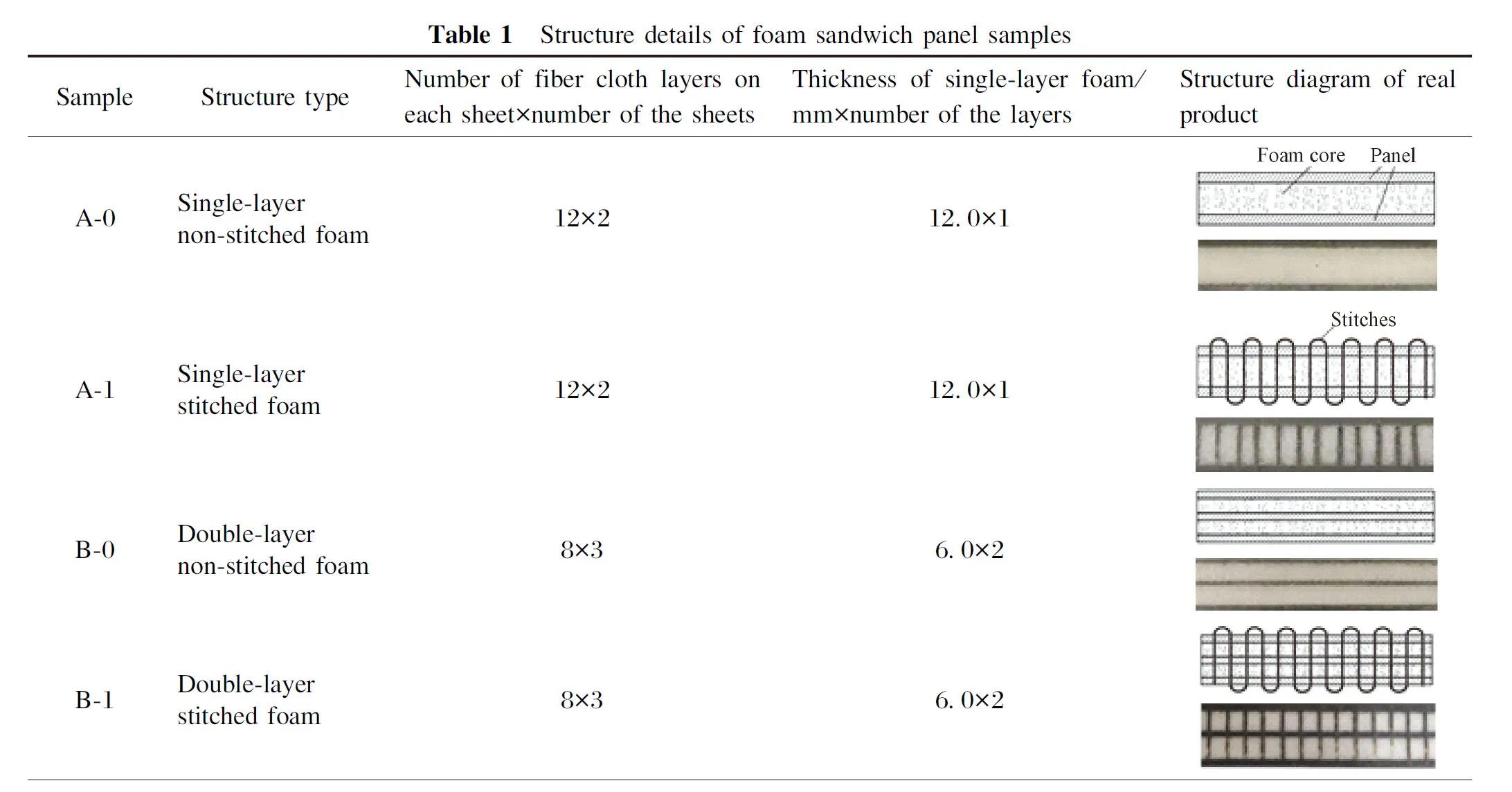
Table 1 Structure details of foam sandwich panel samples

(Table 1 continued)
Various foam sandwich composite samples were formed by RTM technology. They were prepared as follows.
(1) The fiber cloth was infiltrated with a silane coupling agent (KH-560, Qingdao Hengda Zhongcheng Technology Co., Ltd., China). (2) The fiber cloth and foam were cut into the same size as the mold cavity. (3) Holes were drilled in the foam with a diameter of 0.8 mm and a spacing of 5 mm. (4) The fiber cloth and the foam were laminated according to the sample structure presented in Table 1, where the fiber cloth was layered in the manner of [0/90]. (5) The samples were stitched by basalt stitching line pulled from a needle with a diameter of 0.35 mm with a nylon lead thread. (6) Epoxy resin was injected by RTM method, heated to 120 ℃ at a heating rate of 3 ℃/min, then held at 120 ℃ for 180 min, and slowly cooled to room temperature in a curing oven. (7) The foam sandwich panels were cut into standard drop-hammer impact samples by a wire cutter. The preparation process of the samples is shown in Fig.1.

Fig.1 Schematic diagram of the preparation process of the samples
1.2 Experimental methods
The experimental method was based on the ASTM D7 136 test standard, and the impact specimen size was 150 mm×100 mm×17.3 mm, where both the stitch step and stitch space were 5.0 mm and the number of each specimen was 5. The specimen was tested at low velocity by using a drop-hammer impact tester (Instron Dynatup 9250 HV, USA), as shown in Fig.2. The impact head was hemispherical with a diameter of 12.7 mm, and the impact energy was set at 50 J. Then an OmniScan MX 2 ultrasonic device (Japan) was used for nondestructive inspection at room temperature.

Fig.2 Low-velocity impact testing apparatus
2 Results and Analysis
2.1 Low-velocity impact response of non-stitched multi-layer foam sandwich composites
The impact course curves of the non-stitched multi-layer foam sandwich composites are shown in Fig.3(a). In the case of single-layer sandwich panels, the impact process proceeded as follows. The impact load grew gradually with the increase of displacement after the impact head contacted the face sheet. When the stress reached the strength of the face sheet, the face sheet fractured, thus the load dropped rapidly, and the impact head caused a large deformation of the foam. At the same time, the stress was transferred to the face sheet on the bottom side and the load would slow down until the energy was consumed.
The stabilities of the samples experienced the changes in different degrees under the low-velocity impact, which was attributed to the fact that the failure of the resin and fibers in the area in contact with the impact head would occur when the resin and fibers in that area reached their fracture strength accompanying with local debonding between the sheet and the foam. Subsequently, the stress on the sandwich panel would redistribute, and as the impact head continued to move forward, new resin and fibers would continue to fail. The stress would redistribute, and the primary load-bearing areas would continue to adjust.
The difference between a multi-layer foam sandwich panel and a single-layer one was that the load of the former underwent greater degree of fluctuation before reaching its maximum value. On the one hand, the divided sheets were thinner and they absorbed energy prematurely through delamination and fiber breakage. On the other hand, within multi-layer foam sandwich composites, there were more adhesive interfaces between the split sheets and the foam layers, and such sheets were able to absorb energy through interfacial debonding after impact.
It can also be seen from Fig.3(a) that the multi-layer foam sandwich composites take longer to reach the maximum load compared with the single-layer panel. It is because the face sheet is split into several thinner layers and the stiffness of each sheet is reduced. This means that during bending deformation, each thinner panel would produce more deformation without breaking, so it exhibited better deformation capacity. When the multi-layer foam sandwich composite was impacted, each thinner sheet could absorb the energy through its large deformation. Only after the deformation reached its limit, the load would reach its maximum value. Then, the deformation course was longer and the maximum load reached later.
Figure 3(b) shows that the impact energy-time curves are divided into two main stages. Specifically, in the first stage, the energy rose until the maximum value, which was caused by the increase of the load after the impact head contacted the sample. In the second stage, the curve gradually dropped from the maximum value to a fixed value. In this phase, part of the kinetic energy of the impact converted into recoverable elastic strain energy, which caused the impact head to spring back. While the other part was absorbed by the material, causing unrecoverable damage. The total impact energyEi, the highest point of the curve shown in Fig.3(b), is equal to the sum of the elastic strain energyEeand the absorbed energyEa[20]. As shown in Fig.3(b), the energy value of the end point in the curve representsEaof the sample, and the difference betweenEiandEaisEe. The curves converge to stabilize, indicating the end of the impact process. Figure 3(c) displaysEaof all the samples. It is evident that after the foam and the sheets splitting,Eadecreased by 4.2% to 7.0% for each additional layer, which indicated that with the increase of the sandwich number, the irreversible damage gradually decreased.

Fig.3 Typical low-velocity impact response of non-stitched multi-layer foam sandwich composites: (a) contact force-time curves; (b) energy-time curves; (c) absorbed energy of samples
The maximum impact load values for each structural foam sandwich composite are shown in Fig.4. As seen in Fig.4, the number of foam layers has little effect on the maximum contact force. It is probably because the multi-layer partitioning of the foam and the sheets is an adjustment of the material structure and does not change the strength in the sandwich plate thickness direction.

Fig.4 Maximum impact load of multi-layer foam sandwich composites
The ultrasonic nondestructive testing cloud diagrams of the multi-layer foam sandwich composites are shown in Fig.5, where red represents the area with more damage, yellow indicates the area with less damage, and blue denotes the area with no damage. It is obvious that the damage areas of the non-stitched multi-layer foam sandwich composites are more scattered compared with those of the stitched ones. Figure 6 shows the impact damage depth and area of the samples. Compared with those of the non-stitched single-layer foam sandwich composite, the damage depth and damage area of the non-stitched three-layer one dropped by 20.9% and 8.8%, respectively. Meanwhile, the damage depth and damage area of multi-layer foam sandwich composites decreased with the increase of the number of sandwich layers.
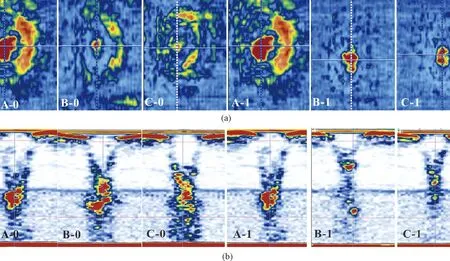
Fig.5 Ultrasonic C-scan images of low-velocity impact damage of multi-layer foam sandwich composites: (a) damage area; (b) damage depth
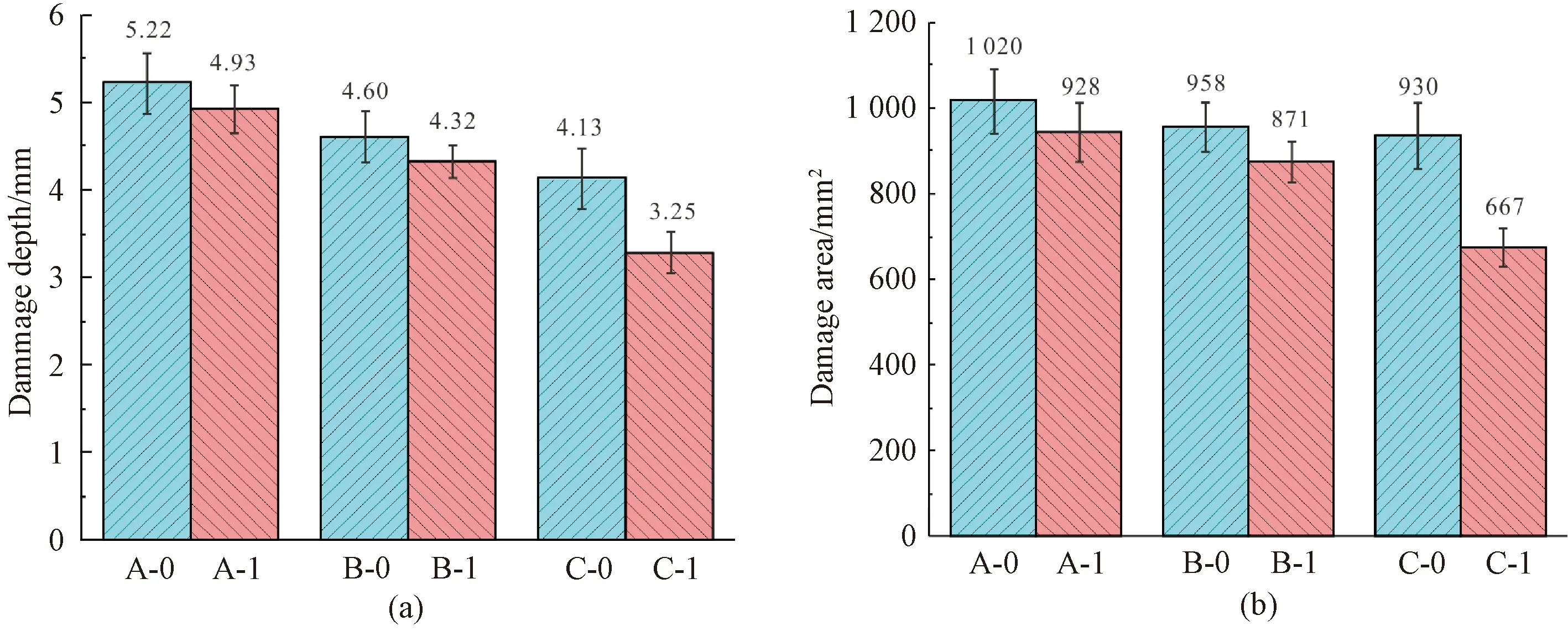
Fig.6 Low-velocity impact damage of multi-layer foam sandwich composites: (a) damage depth; (b) damage area
Figure 7 shows the transverse damage morphology of the low-velocity impacted multi-layer foam sandwich composites. As shown in Fig.7, the impact damage modes of the non-stitched single-layer foam sandwich panels were mainly fiber fracture, fiber delamination and foam fracture, while the damage modes of the non-stitched multi-layer foam sandwich panels also included interlayer cracking of the foam. Although the damage area of the non-stitched multi-layer foam sandwich composites was not significantly different from that of the single-layer one, the fracture area of the fibers as the main load-bearing element was significantly reduced in the multi-layer sandwich material, which indicated that splitting the foam sandwich composite into multiple layers could reduce the impact damage of the material.
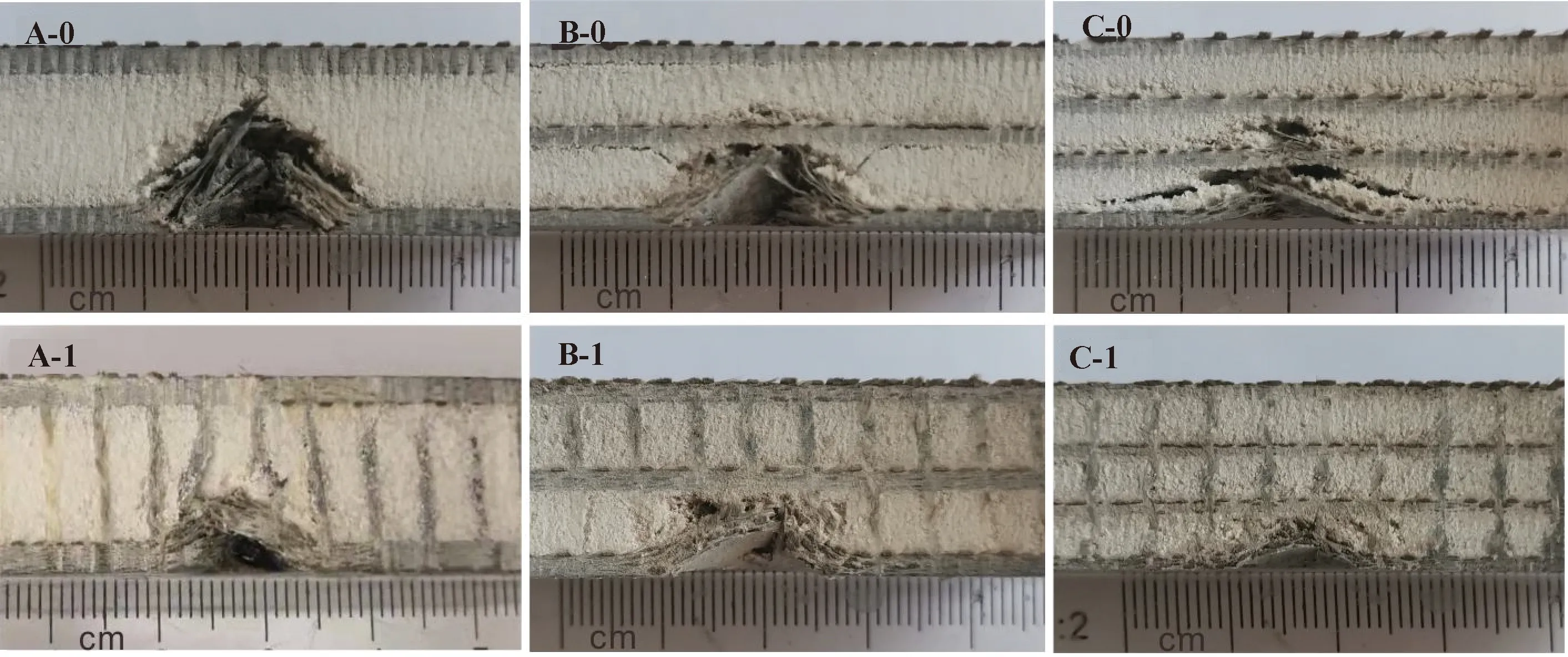
Fig.7 Transverse damage morphology of low-velocity impacted sandwich panels
2.2 Low-velocity impact response of stitched multi-layer foam sandwich composites
The contact force-time curves of the stitched and non-stitched foam sandwich composites are presented in Fig.8. Clearly, the contact forces of the stitched panels grew relatively fast at the beginning. Higher slope of the curve was followed by an increase in the maximum load. This demonstrated that the stitching improved the stiffness and strength of the panel along the thickness direction to some extent. And the maximum impact load of the stitched panels increased by about 5% compared with those of the non-stitched foam sandwich composites (Fig.4). However, the differences in the maximum impact loads of the stitched sandwich panels with different numbers of the layers were not significant. This law was similar to that of non-stitched materials. The reason might be that the splitting of foam and sheets was just an adjustment for the material structure rather than for the strength in the sandwich plate thickness direction.

Fig.8 Typical low-velocity impact curves: (a) single-layer composites; (b) double-layer composites; (c) three-layer sandwich composites
Figure 9(a) shows the energy-time curves of the stitched multi-layer foam sandwich composites. The energy change process followed a similar trend to that of the non-stitched material. Figure 9(b) displays the energy-time curves for the stitched and non-stitched three-layer sandwich composites. Combined with the analysis ofEaof each sample, it could be concluded that the introduction of the stitching line reduced the energy absorption value by about 10% and the stitching reduced the unrecoverable impact damage.

Fig.9 Typical energy-time curves: (a) A-1, B-1, and C-1; (b) C-0 and C-1
As shown in Figs. 5 and 6, under the low-velocity impact, the damage depth and area of the stitched samples are greatly reduced, compared with those of the non-stitched ones. In particular, the damage depth and area of the stitched three-layer foam sandwich composite were reduced by 21.3% and 28.3%, respectively, compared with those of the non-stitched three-layer foam sandwich composites. It was notable that the fracture pattern of the stitched foam sandwich composites was mainly characterized by fracture of the foam and the stitching line and the fibers in the sheet without significant delamination. Further, the failed fibers in the sheets were also significantly reduced, which indicated that the presence of the stitching line inhibited the expansion of cracks. This was because the sheets and the foam were connected into a whole unit through the interfacial bonding effect by the stitching line. Besides, the stitching line transferred the stress better and limited the deformation and cracking of the material in the thickness direction, so as to prevent the crack expansion. Meanwhile, the presence of the stitching line improved the stiffness and strength of the panel in the thickness direction, increasing the energy required to deform the sheet and the foam, thus improving the low-velocity impact resistance of the foam sandwich composites.
It can be seen from Fig.7 that for the impact damage depth, the influence law for the number of the layers of the stitched foam sandwich composites was the same as that of the non-stitched one, both of which showed a gradual decrease in damage depth with increasing the number of the layers; for the impact damage area, the effect of the number of the layers was not significant for the non-stitched foam sandwich composites, while for the stitched panels, the damage area decreased significantly with the increase of the number of the layers. This was because the area and depth of the damage in our study included both foam and fiber damage. Increasing the number of delamination caused a gradual shift in the location of damage from the fibers to the foam. In this case, the synergistic effect of the multi-layer sandwich structure and the stitched structure could significantly improve the low-velocity impact resistance of the foam sandwich composites; the multi-layer structure could disperse the concentrated stress, while the stitched structure could transfer the stress better and inhibit the crack expansion. Compared with those of the non-stitched single-layer foam sandwich composites, the low-velocity impact damage depth, damage area and absorption energy of the stitched three-layer foam sandwich composite decreased by 37.7%, 34.6% and 20.7%, respectively.
3 Conclusions
The low-velocity impact response of stitched multi-layer foam sandwich composites was investigated by drop-hammer impact tests. To analyze the effect of the multi-layer sandwich structure on the low-velocity impact performance, sandwich panels with 2, 3, and 4 layers of sheets were tested while keeping the total thickness constant. Meanwhile, to investigate the effect of stitching on the multi-layer structure, stitched and non-stitched samples of each sandwich structure were tested separately. The conclusions obtained are as follows.
(1) The multi-layer foam sandwich structure reduced the unrecoverable low-velocity impact damage of the material and served to disperse the stress. Compared with the non-stitched single-layer foam sandwich composite, the damage depth and damage area of the non-stitched three-layer foam sandwich composite decreased by 23.0% and 8.8%, respectively. Moreover, the damage depth and damage area gradually decreased with increasing the number of sandwich layers.
(2) The stitched structure improved the integrity of the foam sandwich composites and inhibited the crack expansion, thus improving the low-velocity impact resistance of the multi-layer foam sandwich composites. In addition, the maximum impact load of the stitched foam sandwich composites increased by approximately 5% compared with that of the non-stitched material. Moreover, the damage depth and area of the three-layer foam sandwich composites were reduced by 21.3% and 28.3%, respectively, compared with those of the non-stitched three-layer foam sandwich composites.
(3) The synergistic effect of the stitched structure and the multi-layer sandwich structure significantly improved the low-velocity impact resistance of the foam sandwich composites. Specifically, for the three-layer foam sandwich composites, the low-velocity impact damage depth, damage area and absorbed energy were reduced by 37.7%, 34.6% and 20.7%, respectively, compared with those of the non-stitched single-layer panels.
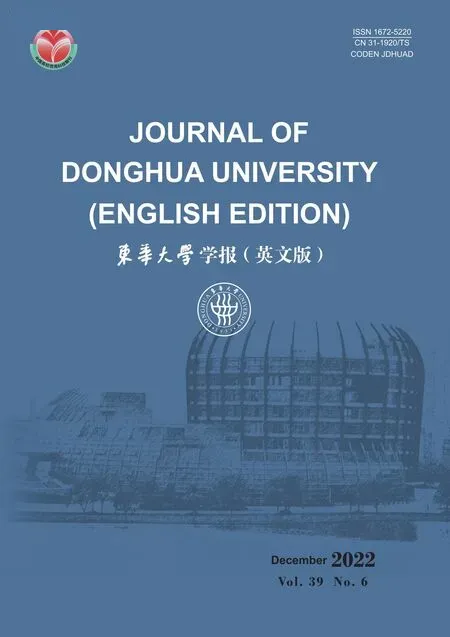 Journal of Donghua University(English Edition)2022年6期
Journal of Donghua University(English Edition)2022年6期
- Journal of Donghua University(English Edition)的其它文章
- Conductive Polyacrylonitrile Fiber Prepared by Copper Plating with L-Ascorbic Acid as Reducing Agent
- Fabrication and Characterization of Yarn-Based Temperature Sensor for Respiratory Monitoring
- Anti-wrinkle Finishing of Cotton Fabrics with Pyromellitic Acid Enhanced by Polyol Extenders
- Preparation and Characterization of Sepiolite Microfibers with High Aspect Ratio
- Solution Blowing of Palygorskite-Based Nanofibers for Methylene Blue Adsorption
- Active Absorption of Perforated Plate Based on Airflow
